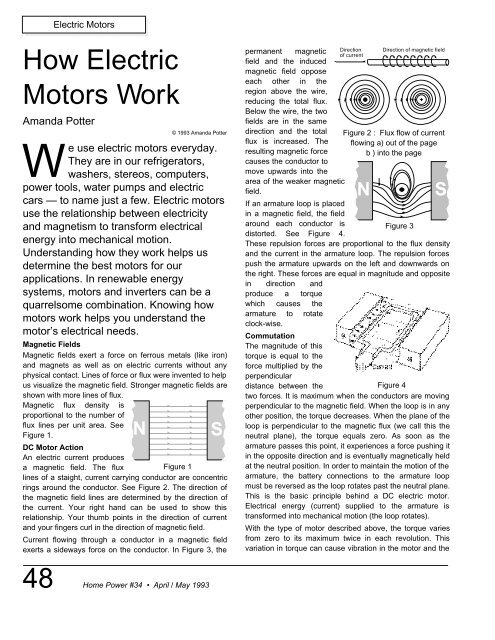You also want an ePaper? Increase the reach of your titles
YUMPU automatically turns print PDFs into web optimized ePapers that Google loves.
Electric MotorsHow ElectricMotors WorkAmanda Potter© 1993 Amanda PotterWe use electric motors everyday.They are in our refrigerators,washers, stereos, <strong>com</strong>puters,power tools, water pumps and electriccars — to name just a few. Electric motorsuse the relationship between electricityand magnetism to transform electricalenergy into mechanical motion.Understanding how they work helps usdetermine the best motors for ourapplications. In renewable energysystems, motors and inverters can be aquarrelsome <strong>com</strong>bination. Knowing howmotors work helps you understand themotor’s electrical needs.Magnetic FieldsMagnetic fields exert a force on ferrous metals (like iron)and magnets as well as on electric currents without anyphysical contact. Lines of force or flux were invented to helpus visualize the magnetic field. Stronger magnetic fields areshown with more lines of flux.Magnetic flux density isproportional to the number offlux lines per unit area. SeeFigure 1. N SDC Motor ActionAn electric current producesa magnetic field. The fluxFigure 1lines of a staight, current carrying conductor are concentricrings around the conductor. See Figure 2. The direction ofthe magnetic field lines are determined by the direction ofthe current. Your right hand can be used to show thisrelationship. Your thumb points in the direction of currentand your fingers curl in the direction of magnetic field.Current flowing through a conductor in a magnetic fieldexerts a sideways force on the conductor. In Figure 3, thepermanent magneticfield and the inducedmagnetic field opposeeach other in theregion above the wire,reducing the total flux.Below the wire, the twofields are in the samedirection and the totalflux is increased. Theresulting magnetic forcecauses the conductor tomove upwards into thearea of the weaker magneticfield.Directionof currentNDirection of magnetic fieldFigure 2 : Flux flow of currentflowing a) out of the pageb ) into the pageSIf an armature loop is placedin a magnetic field, the fieldaround each conductor isFigure 3distorted. See Figure 4.These repulsion forces are proportional to the flux densityand the current in the armature loop. The repulsion forcespush the armature upwards on the left and downwards onthe right. These forces are equal in magnitude and oppositein direction andproduce a torquewhich causes thearmature to rotateclock-wise.CommutationThe magnitude of thistorque is equal to theforce multiplied by theperpendiculardistance between theFigure 4two forces. It is maximum when the conductors are movingperpendicular to the magnetic field. When the loop is in anyother position, the torque decreases. When the plane of theloop is perpendicular to the magnetic flux (we call this theneutral plane), the torque equals zero. As soon as thearmature passes this point, it experiences a force pushing itin the opposite direction and is eventually magnetically heldat the neutral position. In order to maintain the motion of thearmature, the battery connections to the armature loopmust be reversed as the loop rotates past the neutral plane.This is the basic principle behind a DC electric motor.Electrical energy (current) supplied to the armature istransformed into mechanical motion (the loop rotates).With the type of motor described above, the torque variesfrom zero to its maximum twice in each revolution. Thisvariation in torque can cause vibration in the motor and the48 Home Power #34 • April / May 1993
















